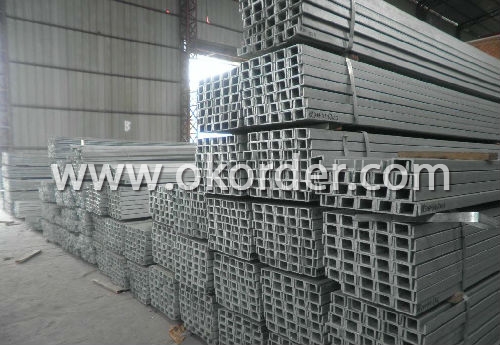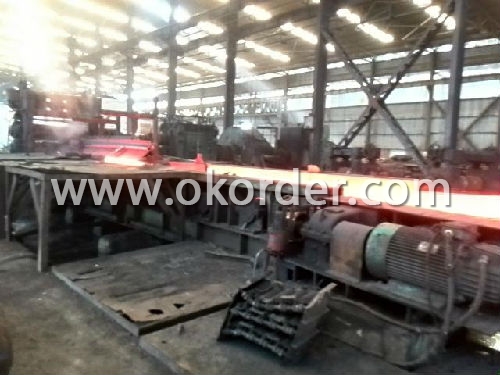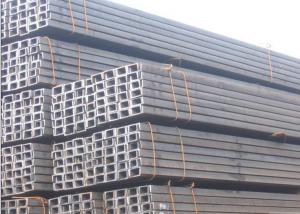Hot Rolled Channel steel
- Loading Port:
- Xingang Port
- Payment Terms:
- TT or LC
- Min Order Qty:
- 25MT m.t.
- Supply Capability:
- 80000-100000MTS/YEAR m.t./month
OKorder Service Pledge
OKorder Financial Service
You Might Also Like
Specifications of Hot Rolled Channel Steel:
1. We are definitely speciallizing in manufacturing and supplying channel steel as per japanese standard, which is characterised with high mechanical strength and competitive prices.
Original Place | Tangshan, China | Brand Name | UINDA |
Standard | JIS G3192 : 1990 | ||
Material Grade | SS540 | ||
Sizes | 50mm to 200mm | ||
Sales Volume/Year | 3000MT | ||
Destination Area | Middle East, Africa, Southeast Asia | ||
2. The sections in details are as followings in the table-1
JIS U CHANNEL | Standard | Sectional | Dimension |
| Mass: |
| (mm) | (mm) | (mm) | (mm) |
|
50x25 | 50 | 25 | 3.0 | 6.00 | 2.37 |
75X40 | 75 | 40 | 3.8 | 7.00 | 5.30 |
75X40 | 75 | 40 | 4.0 | 7.00 | 5.60 |
75X40 | 75 | 40 | 4.5 | 7.00 | 5.85 |
75X40 | 75 | 40 | 5.0 | 7.00 | 6.92 |
|
|
|
|
|
|
100X50 | 100 | 50 | 3.8 | 6.00 | 7.30 |
100X50 | 100 | 50 | 4.2 | 6.00 | 8.03 |
100X50 | 100 | 50 | 4.5 | 7.50 | 8.97 |
100X50 | 100 | 50 | 5.0 | 7.50 | 9.36 |
|
|
|
|
|
|
125X65 | 125 | 65 | 5.2 | 6.80 | 11.66 |
125X65 | 125 | 65 | 5.3 | 6.80 | 12.17 |
125X65 | 125 | 65 | 5.5 | 8.00 | 12.91 |
125X65 | 125 | 65 | 6.0 | 8.00 | 13.40 |
|
|
|
|
|
|
150x75 | 150 | 75 | 5.5 | 7.30 | 14.66 |
150x75 | 150 | 75 | 5.7 | 10.00 | 16.71 |
150x75 | 150 | 75 | 6.0 | 10.00 | 17.90 |
150x75 | 150 | 75 | 6.5 | 10.00 | 18.60 |
150x75 | 150 | 75 | 6.5 | 10.00 | 24.00 |
|
|
|
|
|
|
200X80 | 200 | 80 | 7.5 | 11.00 | 24.60 |
Table-1
3. The mechanical property of Hot Rolled Channel Steel in the table-2:
Grade | Yield Strength,N/mm² | Extension Strength N/mm² | |||
Thickness of Steel,mm | |||||
≦16 | >16-≦40 | >40-≦100 | >100 | ||
SS540 | ≧400 | ≧390 | - | - | ≧540 |
Table-2
4. The chemical composition of Hot Rolled Channel Steel as per SS540 in the table-3
Grade | Yield Strength,N/mm² | Extension Strength N/mm² | |||
Thickness of Steel,mm | |||||
≦16 | >16-≦40 | >40-≦100 | >100 | ||
SS540 | ≧400 | ≧390 | - | - | ≧540 |
Table-3
Usage of Hot Rolled Channel Steel:
1.The Hot Rolled Channel Steel can be devided into two kinds, namely common channel steel and light channel steel. The sizes of hot rolled common channel steel range from 5# to 40#. Meanwhile, the channel steel can be divided into cold forming sectional equal channel steel, cold forming sectional unequal channel steel, cold forming inner edge channel steel and outer edge channel steel.
2.The hot rolled channel steel is usually used for arch-itechtural structure, and they could be welded in order to support or hang a vari-ety of facilities. They are also usually used in combination with I beam. The channel steel with sizes under 14# is usually applied to construction engineering, as purline, while the channel steel with sizes above 16# is more likely to be used in building vehicle chassis structure and mechanical structure. Furthermore, the channel steel in sizes above 30# are target at building bridge structure, as tension bar.
3.In a word, the channel steel must possess perfect welding property, riveting property and mechanical property and so on.
Package & Delivery of Hot Rolled Channel Steel:
1.The hot rolled channel steel will be packed in bundle with steel wire at each end of every bundle and color marking in order to help the customer to recognize his goods more easily at sight.
2. And the channel steel could be loaded into 20ft or 40ft container, or by bulk cargo.If the weight of each bundle reaches more than 3.5 mt, the loading by break bulk cargo should be choosed.When the weight of each bundle reaches less than 3mt, the loading by container should be choosed.
3.As for the transportaion from mill to loading port, the truck will be usually used. And the maximum quantity for each truck is 40mt.
4.All in all, we could do in accordance with customer's request.

Production Flow of Hot Rolled Channel Steel:
1.The steel billet shall be heated in the high temperature furnace.
2. The heated steel billet shall be rolled five to nine times with the aim of shaping the general figure of steel u channel.
3. The rolled steel u channel should be put onto the cooling bed to make the temperature low.
4. The steel u channel should be straighted on the straightener.
5. The straighted steel u channel will be cut into meters by saw, as per customer's requirements.
6. At the last part of production, the channel steel must be tested in order to confirm that the finished products are completely free from crack, pore, slag, scab or fold on the surface.

- Q:What are the different types of loads that steel channels can bear?
- Steel channels exhibit versatility as structural components capable of bearing different types of loads. The array of loads they can endure includes: 1. Compression Load: With a high load-bearing capacity, steel channels can effectively withstand compression forces. They find common usage in columns and beams, providing support for the weight of structures and facilitating vertical load transfer. 2. Tension Load: Steel channels possess the capability to resist tension loads, effectively countering forces that aim to pull or stretch the material. This attribute renders them appropriate for applications such as trusses or suspension systems. 3. Shear Load: Steel channels exhibit resilience against shear forces, which arise when two parallel forces exert themselves in opposite directions. They frequently find application in structural systems, effectively counteracting the shearing effects of horizontal loads like wind or seismic forces. 4. Bending Load: Steel channels proficiently bear bending loads, which emerge when forces are applied perpendicularly to the channel's axis. They are often utilized as beams or lintels, providing support for loads positioned over openings like doors or windows. 5. Axial Load: Steel channels are designed specifically to withstand axial loads, which act along the channel's longitudinal axis. These loads can either be compressive or tensile and are typically encountered in columns or vertical members. 6. Lateral Load: Steel channels possess the ability to bear lateral loads, which exert themselves perpendicular to the channel's longitudinal axis. These loads commonly originate from wind, earthquakes, or other horizontal forces and are effectively countered by the structural system incorporating the channel. In conclusion, steel channels offer a versatile option for structural applications due to their capacity to bear various types of loads. Their strength, durability, and flexibility render them suitable for an extensive range of construction and engineering projects.
- Q:Can steel channels be used for staircase construction?
- Yes, steel channels can be used for staircase construction. Steel channels are durable and strong, making them suitable for supporting the weight and ensuring the stability of the staircase structure. The use of steel channels in staircase construction can also provide a modern and sleek appearance to the staircase design.
- Q:What are the different connection methods for steel channels?
- Different connection methods are available for steel channels, depending on the desired structural integrity and application. Some commonly used methods include: 1. Welding: Steel channels can be connected by melting their edges and joining them together using heat. This method requires skilled welders and can be time-consuming, but it provides a strong and durable connection. 2. Bolting: Another common method is using bolts and nuts to secure the steel channels. This method is relatively quick and allows for disassembly if needed. However, it may not offer the same level of strength as welding. 3. Riveting: Heavy-duty applications often use riveting, where metal pins or rivets are used to join the steel channels. This method provides a strong and permanent connection but requires special tools and skilled labor. 4. Adhesive bonding: High-strength adhesives or epoxy can be used to bond steel channels together. This method offers a strong and flexible connection but may not be suitable for all applications and requires proper surface preparation and curing time. 5. Mechanical connectors: Mechanical connectors like beam hangers or brackets can also be employed to connect steel channels. These connectors provide a quick and easy method but may not offer the same level of structural integrity as other methods. When selecting a connection method for steel channels, it is crucial to consider factors such as load-bearing capacity, structural design requirements, and ease of installation. Consulting with a structural engineer or construction professional can help ensure the appropriate method is chosen for a specific project.
- Q:How do steel channels contribute to natural ventilation?
- Steel channels can contribute to natural ventilation by providing a pathway for the flow of air. When strategically placed within a building or structure, steel channels can help facilitate the movement of fresh air from outside, allowing for proper air circulation and ventilation.
- Q:What does "channel weight" mean?
- The theoretical weight of channel steel is based on the specification of channel steel. The steel Handbook and the number of kilograms per meter are listed on the steel handbook. That is, the reason for the channel steel (weight)
- Q:How are steel channels installed on-site?
- Steel channels are typically installed on-site by first preparing the foundation or support structure. The channels are then positioned and aligned according to the design specifications. They are secured in place using welding, bolting, or concrete embedding methods. The installation process may also involve leveling, aligning, and ensuring proper connections with other structural elements.
- Q:What are the common lengths of steel channels?
- The common lengths of steel channels can vary depending on the specific application and manufacturer. However, some standard lengths are commonly available in the market. These include 10 feet (3.048 meters), 20 feet (6.096 meters), and 24 feet (7.315 meters). These lengths are often preferred due to their convenience in transportation and handling. It is important to note that custom lengths can also be ordered from manufacturers to suit specific project requirements.
- Q:Can steel channels be used for scaffoldings?
- Scaffoldings can indeed utilize steel channels. In the construction industry, steel channels find widespread use for a multitude of purposes, one of which includes scaffolding systems. They possess exceptional strength, durability, and load-bearing capabilities, making them a fitting option for supporting both workers and materials at elevated heights. The assembly and disassembly of steel channels are effortless, allowing for a scaffold design that is flexible and adaptable. Moreover, their resistance to corrosion renders them perfect for outdoor applications, where exposure to weather elements is a concern. All in all, steel channels provide a dependable and robust solution for scaffoldings, guaranteeing the safety and stability of both workers and the construction project.
- Q:Can steel channels be used for creating support structures for communication towers?
- Yes, steel channels can be used for creating support structures for communication towers. Steel channels are commonly used in construction due to their strength and durability. They provide excellent support for heavy loads and can withstand various environmental conditions, making them suitable for use in communication tower structures. Steel channels can be easily fabricated, cut, and welded to meet the specific requirements of the tower design. Additionally, their uniform shape and consistent dimensions make them ideal for creating stable and reliable support structures.
- Q:What are the different types of hangers used for steel channels?
- There are several different types of hangers used for steel channels, including clevis hangers, u-bolt hangers, pipe hangers, and beam clamps. These hangers are designed to provide support and secure the steel channels in various applications, such as construction, plumbing, and electrical installations. Each type of hanger has its own specific design and mounting method to accommodate different channel sizes and load capacities.
1. Manufacturer Overview |
|
|---|---|
| Location | Tangshan, China |
| Year Established | 2000 |
| Annual Output Value | Above US$ 50 Million |
| Main Markets | Mid East; Southeast Asia; Korea |
| Company Certifications | |
2. Manufacturer Certificates |
|
|---|---|
| a) Certification Name | |
| Range | |
| Reference | |
| Validity Period | |
3. Manufacturer Capability |
|
|---|---|
| a)Trade Capacity | |
| Nearest Port | Tianjin |
| Export Percentage | 20% - 30% |
| No.of Employees in Trade Department | 10-20 People |
| Language Spoken: | English; Chinese |
| b)Factory Information | |
| Factory Size: | Above 81,000 square meters |
| No. of Production Lines | 1 |
| Contract Manufacturing | OEM Service Offered |
| Product Price Range | Average |
Send your message to us
Hot Rolled Channel steel
- Loading Port:
- Xingang Port
- Payment Terms:
- TT or LC
- Min Order Qty:
- 25MT m.t.
- Supply Capability:
- 80000-100000MTS/YEAR m.t./month
OKorder Service Pledge
OKorder Financial Service
Similar products
New products
Hot products
Hot Searches
Related keywords


























